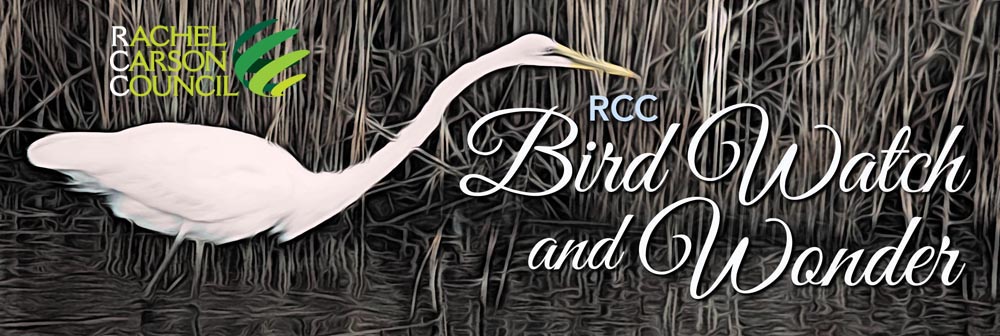 | | | This July issue of RCC’s Bird Watch and Wonder is a love fest for birds. The loving interaction between species – between us humans and our feathered friends – gives me hope even as birds across the United States (and the world) continue to be threatened by manmade structures, products, poisons, dwindling habitats thanks to relentless development, and, of course, human-induced climate change that has now made our planet hotter than it has been in at least 125,000 years. You and I need to act, and quickly. Rachel Carson and many other naturalists, ecologists, writers have believed that we are less likely to harm or kill what we love. That’s why my review of Jennifer Ackerman’s masterful, new narrative, What An Owl Knows, is called a love story. It is why Meena Miriam Yust’s look at how the oil-drilling Willow Project in Alaska threatens what she calls a “honeymoon haven” for 600,000 shorebirds who migrate to this “Paris of the avian world.” 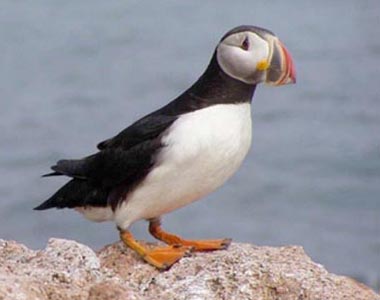 Or, look at the photograph that adorns the report of a new study from the University of Maine that examines increasing heat and seabird die-off. It is the beloved, clown-clad Atlantic Puffin. Or, look at the photograph that adorns the report of a new study from the University of Maine that examines increasing heat and seabird die-off. It is the beloved, clown-clad Atlantic Puffin.
Jennifer Ackerman’s book concludes with a woman holding a tiny Elf Owl on the tip of her finger. Dan Gunderson’s story about how our now erratic weather affects birds that devour insects on the wing features his close-up photo of an almost transparent Tree Swallow being ever so gently held and measured by researcher Annie Bracey.
The same caring treatment marks Sheri Williamson's research as she examines a lovely, iridescent hummingbird in Arizona and then quietly, gently places it onto the palm of an 8-year-old whose life will undoubtedly be changed. These are love stories, indeed. It is why, I believe, the more we humans come to love the birds and the places they live and love in, the more we will want to help them, protect them. So savor this love fest that is our July issue. Bird art, bird photography, Ross Feldner's latest tips on how native plants attract more birds into your backyard world, the best of “Bird of the Week” and “Momentary Meditations” (an owl, of course…), a Weekly Warbler blog on how fishing boats affect seabirds (yes, puffins) by RCC’s correspondent, Lisa Mills, and much more. All are love stories. | | | | | | | | 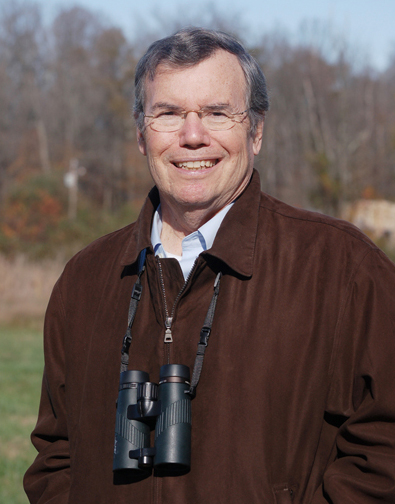 Bob Musil is the President & CEO of the Rachel Carson Council and author of Rachel Carson and Her Sisters: Extraordinary Women Who Have Shaped America’s Environment (Rutgers, 2016) and Washington in Spring: A Nature Journal for a Changing Capital (Bartleby, 2016). He is also the editor of the forthcoming annotated edition from Rutgers University Press of Rachel Carson’s Under the Sea-Wind with his Introduction, updated marine science, and historic and contemporary illustrations and photographs. Bob Musil is the President & CEO of the Rachel Carson Council and author of Rachel Carson and Her Sisters: Extraordinary Women Who Have Shaped America’s Environment (Rutgers, 2016) and Washington in Spring: A Nature Journal for a Changing Capital (Bartleby, 2016). He is also the editor of the forthcoming annotated edition from Rutgers University Press of Rachel Carson’s Under the Sea-Wind with his Introduction, updated marine science, and historic and contemporary illustrations and photographs. | | | | | | The Willow Project Threatens Alaska Bird Breeding Paradise Of all places in the world to destroy, let’s not make the birds’ honeymoon haven one of them. Under the beautiful iridescent Northern sky lies a haven for birds, a Paris of the avian world, its Eiffel Tower a beautiful lake, its accordion the sound of birdsong, its wine the emerald-green of the Northern lights. Birds flock from thousands of miles away to this nesting spot now commonly called ‘lover’s lane’—it is where they raise their baby chicks. | | | | | | | | Seabird Die-Offs Linked to Marine Heat Waves A new study, led by researchers at the University of Washington, has linked mass seabird die-offs to marine heat waves. The study, published in the journal Marine Ecology Progress Series, analyzed data collected from residents along coasts from Alaska to central California from 1993 to 2021. The researchers were looking to find if these marine heat wave events were affecting seabirds, which are near the top of the food chain for coastal regions. | | | | | | | | Birds, Bugs and Climate Change Is erratic weather affecting bird nutrition? Early on a cool, smoky June morning researchers Alexis Grinde and Annie Bracey load up with gear and strike out across a grassland south of Moorhead, Minn. They’re gathering data to better understand how changing weather might be affecting nutrition for aerial insectivores, birds that catch insects in flight. | | | | | | | | On Arizona's San Pedro River, Hummingbirds Reflect the Health of a Landscape Sheri Williamson blew on the feathers of the small hummingbird in her hand using a short blue straw. Next to her, a volunteer typed into a spreadsheet the bird's wing length, weight and sex, along with the five digits in the tiny numbered metal band on the bird’s leg. A volunteer fed the hummingbird sugared water, and placed it on the extended palm of an 8-year-old spectator. The bird quivered, seemed to doze for a minute, and took flight. | | | | | | | | From Sea to Sky: How Seafood Harvesting is Affecting Seabirds Don’t get me wrong, I love seafood as much as the next person. I can inhale sushi at an alarming rate, can never pass up a fresh tuna steak, and basically anything with shrimp in it is practically calling my name. Fresh seafood is a great source of lean protein, and is absolutely delicious. Humans have always existed alongside the ocean’s bounty, and it is such an important part of our diet and identity. But there is a dark side to seafood that not many people know about. | | | | | | | | | | Bridge for the Birds, Installed in Wilmington, Carries Civil Rights Message Thomas Burke (right) oversees the installation of his massive miniature replica - in birdhouse form - of the Edmund Pettus Bridge in Wilmington's Tubman-Garrett Riverfront Park, Thursday, June 29, 2023. It is the second civil rights-related creation that Burke, who builds intricate birdhouses modeled after notable structures, has placed in the park. The bridge is known as the location of the Bloody Sunday attack against civil rights protestors in Selma, Ala., in 1965. | | | | | | | | Poem of the Week: Dear Bird by Howard Altmann A dead bird stumbled upon during a walk leads the poet on an inward journey confronting historical and biological cycles and the act of writing itself. Dear Bird: A dead bird in the snow is not how I wish to begin this walk, yet there it is, feathers all bloodied and frozen to the ground, giving flight to cause and effect, the mind trampled by where it has gone before, an image faithfully lodged, falling along sandy shores and leafy trails, in the chaos of a lonely night, dear bird might you share your name, must I nurse you till the end, | | | | | | | | Globetrotting Photographer Snaps 2,000 Bird Species, But No Ivory-billed Woodpecker in Arkansas After a successful career providing wildlife researchers with tools to investigate many living creatures, in retirement Robert Hawkins has focused on birds — all over the world. Hawkins' photography studio has no walls. With a pair of binoculars constantly at hand, he scarcely ever ventures outdoors without a camera. Even indoors, he is looking out the window of his high seaside apartment, watching for a gull or frigate bird to exhibit some novel behavior that he can capture on film. | | | | | | | | When Did the Rhode Island Red Chicken Become the Rhode Island State Bird? The Rhode Island Red Chicken became the state bird of Rhode Island on May 3, 1954. It won out over the Rhode Island Hen, which had a legislator backing it. Other birds that were considered included the Ruby-Throated Hummingbird and the Towhee. The Rhode Island Red Chicken had more votes than the Rhode Island Hen, so it won the title of state bird. It was likely so popular because it has a calm and friendly nature that makes them a good choice as a backyard pet or free-range chicken. | | | | | | | | Extinct or Elusive? Why Birders Aren’t Giving Up on the Ivorybill. Matt Courtman was 8 years old when he first saw an ivory-billed woodpecker, possibly the most famous and controversial bird in American history. It happened not in some deep Southern swamp or lonely river, bottom forest places where ivorybills once flourished, but in the Museum of Natural Science at Louisiana State University in Baton Rouge. The museum holds one of the largest university-based collections of bird specimens in the country and, in Mr. Courtman’s memory, smelled heavily of formaldehyde. | | | | | | | | Central Texans Face Hawk Attacks During Nesting Season Jean Marchione and Dan Spence's summer outfits include umbrellas, hard hats and goggles. They're not avoiding any rain or working on a construction site. Instead, the pair have spent weeks trying to coexist with the very aggressive broad-winged hawk nesting above their South Austin home. Driving the news: They're not alone. Each year, Texas Parks and Wildlife receives multiple calls about aggr | | | | | | | | More Native Plants = More Birds! What Are Native Plants? The US Forest Service defines native plants as indigenous terrestrial and aquatic species that have evolved and occur naturally in a particular region, ecosystem, and habitat. Species native to North America are generally recognized as those occurring on the continent prior to European settlement. They represent a number of different life forms, including conifer trees, hardwood trees and shrubs, grasses, forbs, and others. | | | | | | | | An Audio Postcard to Future Generations: Volunteers Document Bird Sounds of Acadia The mountains, lakes, deep woods and rugged coastlines of Maine's Acadia National Park are home to more than 300 species of birds. Volunteers are making recordings to document the avian soundscape, which is changing quickly. At sunrise on a June morning, Laura Sebastianelli is starting off down a trail in Acadia National Park. She's wearing headphones and holding a big microphone that looks like a satellite dish about the diameter of a large pizza. Soon, she aims it in the direction of a warbler. | | | | | | | | Three Peregrine Falcon Chicks Take Flight at Harpers Ferry It marks the first time in years that an entire brood of peregrine falcon chicks has survived and taken flight from cliffs that were once a historic breeding site. Wildlife experts have placed young peregrine falcon chicks at the cliffs in Harpers Ferry National Historical Park, hoping they would eventually return to nest there and breed, but they never had success until three years ago, when an adult pair made a nest there. | | | | | | | | I Became a Better Birder When I Stopped Focusing on the Males Kenn Kaufman reflects on ingrained biases in birding—and how moving past them gave him a whole new perspective. I knew a birder once who boasted of the high standards for his life list: He would not count a new species until he had seen an adult male. If the sexes looked the same, any individual would suffice. But if there were differences, he wouldn’t settle for a mere female; he had to see a male before he’d write it on the list. | | | | | | | | Loggerhead Shrike Looking like a black-masked bandit this distinctive bird is also known as the “butcherbird” because of its habit of skewering its prey on thorns or barbed wire before it eats it. Planning ahead, they will amass prey as security against leaner times. The “shrike” part of its name is derived from an Old English work for “shriek” which is a reference to its harsh sounds while the “loggerhead” part is a reference to the large head in relation to its body. | | | | | | | | Timeless Wisdom My mind has already turned to thoughts of spring and getting into the garden when the snow melts. Then, I encountered this Barred Owl, and was reminded of the wisdom of living in the moment, even when my mind begins planning for the future. | | | | | | | | A Love Story: Rachel Carson, Jennifer Ackerman
and the Wonder of Living Things Jennifer Ackerman, What An Owl Knows: The New Science of the World’s Most Enigmatic Birds
(Penguin Press, 2023). 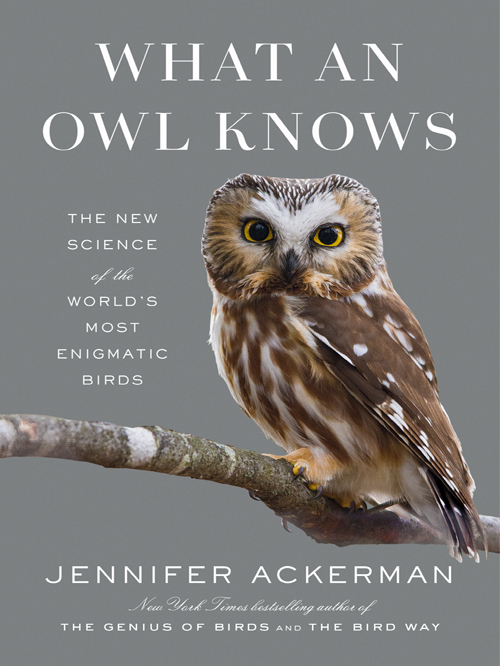 Jennifer Ackerman’s What An Owl Knows is a love story. It concludes with Black conservationist and photographer Day Scott, who suffered a traumatic brain injury in a vehicle crash, holding an Elf Owl, the world’s smallest, about the size of a sparrow, in her hand. Day, who is studying the habitats and effects of climate change on six small owl species on Norfolk Island in Australia, wonders what they are both thinking. “I felt like I partially knew. She is so tiny and fragile, and we are so big… I was looking at her and feeling like we had some kind of connection, because I was trying to care for her in the best way I possibly could. And whatever the importance of life was, right then it came down to this one owl I was holding in my hand.” Jennifer Ackerman’s What An Owl Knows is a love story. It concludes with Black conservationist and photographer Day Scott, who suffered a traumatic brain injury in a vehicle crash, holding an Elf Owl, the world’s smallest, about the size of a sparrow, in her hand. Day, who is studying the habitats and effects of climate change on six small owl species on Norfolk Island in Australia, wonders what they are both thinking. “I felt like I partially knew. She is so tiny and fragile, and we are so big… I was looking at her and feeling like we had some kind of connection, because I was trying to care for her in the best way I possibly could. And whatever the importance of life was, right then it came down to this one owl I was holding in my hand.”
Or, take the amazing abilities of Marjon Savelsberg to hear and distinguish between the sounds produced by individual owls. Savelsberg did not plan to study owls. A trained classical musician who studied with the Johann Strauss Orchestra, Savelsberg had to give up music as she developed difficulty breathing and controlling her muscles. Doctors said that her idiopathic cardiomyopathy would not let her live more than a decade. Instead she took to studying owl vocalizations, both listening to variations in timing, timbre, and pitch, as well as analyzing spectrograms. Now she has been given special permission to enter a large, dark quarry in a natural area, riding a mobility scooter to listen and get recordings of Eurasian Eagle Owls. Her research helps transform what we know about owls. But it is Savelsberg’s own transformation by owls and their allure that is of equal importance. “From that moment on I was allowed to go into areas where no one else could go,” she explains. “I suddenly had colleagues again and was seen as much more than someone with a disability. After having to give up music, I had been so depressed.” Savelsberg realizes she is still a musician and that “All the skills I learned, the talent I have, I can still use…Because I am so fascinated by sound, I can do a lot for this bird.” Read more. Purchase here | | | | | | A Wing and a Prayer
The Race to Save Our Vanishing Birds By Anders Gyllenhaal and Beverly Gyllenhaal 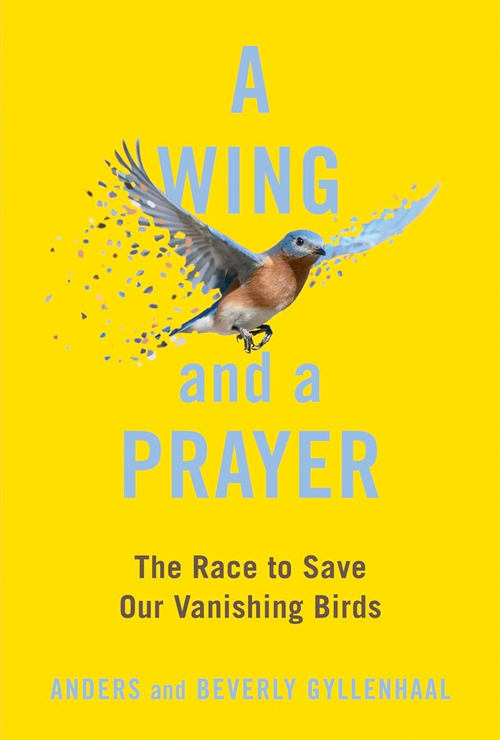 A captivating drama from the frontlines of the race to save birds set against the devastating loss of one third of the avian population. A captivating drama from the frontlines of the race to save birds set against the devastating loss of one third of the avian population.
Three years ago, headlines delivered shocking news: nearly three billion birds in North America have vanished over the past fifty years. No species has been spared, from the most delicate jeweled hummingbirds to scrappy black crows, from a rainbow of warblers to common birds such as owls and sparrows.
In a desperate race against time, scientists, conservationists, birders, wildlife officers, and philanthropists are scrambling to halt the collapse of species with bold, experimental, and sometimes risky rescue missions. High in the mountains of Hawaii, biologists are about to release clouds of laboratory-bred mosquitos in a last-ditch attempt to save Hawaii’s remaining native forest birds. In Central Florida, researchers have found a way to hatch Florida Grasshopper Sparrows in captivity to rebuild a species down to its last two dozen birds. In the Sierra Nevada Mountains, a team is using artificial intelligence to save the California Spotted Owl. In North Carolina, a scientist is experimenting with genomics borrowed from human medicine to bring the long-extinct Passenger Pigeon back to life. For the past year, veteran journalists Anders and Beverly Gyllenhaal traveled more than 25,000 miles across the Americas, chronicling costly experiments, contentious politics, and new technologies to save our beloved birds from the brink of extinction. Through this compelling drama, A Wing and a Prayer offers hope and an urgent call to action: Birds are dying at an unprecedented pace. But there are encouraging breakthroughs across the hemisphere and still time to change course, if we act quickly. Read more and purchase here. | | | | | | The July 2023 issue of Bird Watch and Wonder was produced by Ross Feldner. | | | | | |  The Rachel Carson Council Depends on Tax-deductible Gifts From Concerned Individuals Like You. Please Help If You can. The Rachel Carson Council Depends on Tax-deductible Gifts From Concerned Individuals Like You. Please Help If You can. | | | |  Sign Up Here to Receive the RCC E-News and Other RCC Newsletters, Information and Alerts. Sign Up Here to Receive the RCC E-News and Other RCC Newsletters, Information and Alerts. | | | | | | | | | | | |